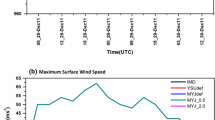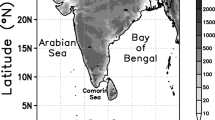Abstract
Purpose
In this paper, an attempt has been made to delineate the physical processes which lead to the westward movement of the North Indian Ocean tropical cyclone LEHAR.
Methods
The Advanced Weather Research and Forecasting (ARW) model is used to simulate LEHAR with 27 and 9 km resolutions. In addition to that, all terms of the complete vorticity equation are computed to obtain the contribution of each term for the vorticity tendency. The vorticity tendency is calculated in four sectors, namely northwest, northeast, southwest, and southeast and assumed that the cyclone moves from its existing location to the nearest point where the vortices tendency is maximum.
Results
The results indicate that the model performed well in simulating the characteristics of cyclone compared with the Satellite and other observations. It is noticed that the vorticity stretching term contributes most to the positive vorticity tendency. The second highest contribution is from the horizontal advection thus indicating the secondary importance of steering.
Conclusions
The distribution of lightning flash rates are higher in the SW and followed by NW sectors of the cyclone indicate more strong convective clouds are in SW sector. The equivalent potential temperatures (θ e) at different stages of before, during and after the mature stage of the cyclone reveals that the wind-induced surface heat (WISH) exchange process is a plausible mechanism for the intensification of LEHAR.













Similar content being viewed by others
References
Adem (1956) A series solution for the barotropic vorticity equation and its application in the study of atmospheric vortices. Tellus 8:364–372
Ali MM, Jagadeesh PSV, Jain S (2007) Effects of eddies and dynamic topography on the Bay of Bengal cyclone intensity. Eos, Transactions, Am Geophysical Union 88:93–95
Belangar JI, Webster PJ, Curry JA, Jelinik MT (2012) Extended prediction of north Indian ocean Tropical cyclones. Wea. Froecasting 27:757–769
BhaskarRao DV, Hari Prasad D (2006a) Sensitivity of tropical cyclone intensification to boundary layer and convective processes. Nat Hazards. https://doi.org/10.1007/s11069-006-9052-7
BhaskarRao DV, Hari Prasad D (2006b) Numerical prediction of the Orissa super cyclone (1999): sensitivity to the parameterisation of convection, boundary layer and explicit moisture processes. Mausam 57:61–78
BhaskarRao DV, Hari Prasad D, Srinivas D (2009) Impact of horizontal resolution and the advantages of the nested domains approach in the prediction of tropical cyclone intensification and movement. J Geophysical Res (Atmosphere) 114:D11106. https://doi.org/10.1029/2008JD011623
BhaskarRao DV, Hari Prasad D, Srinivas D, Anjaneyulu Y (2010) Role of vertical resolution in numerical models towards the intensification, structure and track of tropical cyclones. Mar Geodesy 33(4):338–355. https://doi.org/10.1080/01490419.2010.518066
Chan JCL (1984) Definition of the steering flow for tropical cyclone motion. In: Proc. 15th Conf. Hurr. Trop. Meteor. Soc., Boston MA, vol. 02108, pp 559-566
Chan JC-L (1985) Identification of the steering flow for tropical cyclone motion from objectively analysed wind fields. Mon Wea Rev 113:106–116
Chan JC-L, Gray WM (1982) Tropical cyclone movement and surrounding flow relationships. Mon Wea Rev 110:1354–1374
Chan JC-L, Williams RT (1987) Analytical and numerical studies of the beta-effect in tropical cyclone motion. Part 1: zero mean flow. J Atmos Sci 44:1257–1265
Charney JG, Eliassen A (1964) On the growth of hurricane depression. J Atmos Sci 21:68–75
DeMaria M (1985) Tropical cyclone motion in a non-divergent barotropic model. Mon Wea Rev 113:1199–1209
Dudhia J (1989) Numerical study of convection observed during winter monsoon experiment using a mesoscale two-dimensional model. J Atmos Sci 46:3077–3107
Emanuel K (2004) Tropical cyclone energetics and structure. In: Fedorovich E, Rotunno R, Stevens B (eds) Atmospheric turbulence and mesoscale meteorology. Cambridge Univ. Press, Cambridge, pp 165–191
Evan Amato T, Camargo Suzana J (2011) A Climatology of Arabian Sea Cyclonic Storms. J. Climate 24:140–158
Fiorino M, Elsberry RL (1989a) Some aspects of vortex structure related to tropical cyclone motion. J Atmos Sci 46:975–990
Fiorino M, Elsberry RL (1989b) Contributions to tropical cyclone motion by small, medium and large scales in the initial vortex. Mon Wea Rev 117:721–727
Franklin JL (1990) Drop windsonde observations of the environmental flow of hurricane Josephine (1984), relationships to vortex motion. Mon Wea Rev 118:2732–2744
Franklin JL, Feuer SE, Kaplan J, Aberson SD (1996) Tropical cyclone motion and surrounding flow relationship: searching for beta gyres in omega dropwindsonde datasets. Mon Wea Rev 124:64–84
Gray WM (1989) Summary of ONR sponsored tropical cyclone motion research and future plans, Appendix D of Tech. Rep. NPS 63-89-002, vol 93943. Naval Postgraduate School, Montery, pp 68–79
Hari Prasad D, Bhaskar rao DV (2015) A diagnostic study of Bay of Bengal tropical cyclone (Orissa super cyclone) movement and intensity. Int J Earth Atmos Sc 1(3):115–131
Haynes PH, Mcintyre ME (1987) On the evolution of vorticity and potential vorticity in the presence of diabatic heating and frictional or other forces. J Atmos Sci 44(5):828–841
Hess SL (1959) Introduction to theoretical meteorology. Q J R Meteorol Soc 86(368). doi:10.1002/qj.49708636824
Holland GJ (1984) Tropical cyclone motion: a comparison of theory and observation. J Atmos Sci 41:68–75
Hong S-Y, Noh Y, Dudhia J (2006) A new vertical diffusion package with explicit treatment of entrainment processes. Mon Wea Rev 134:2318–2341
Huffman GJ, Bolvin DT (2012) TRMM and other data precipitation data set documentation. (ftp://meso-a.gsfc.nasa.gov/pub/trmmdocs/3B42_3B43_doc.pdf)
Huffman GJ, Adler RF, Bolvin DT, Gu G, Nelkin EJ, Bowman KP, Hong Y, Stocker EF, Wolff DB (2007) The TRMM multi-satellite precipitation analysis: quasi-global, multi-year, combined-sensor precipitation estimates at fine scale. J Hydro meteorol 8:38–55. https://doi.org/10.1175/JHM560.1
India Meteorological Department (2014) Nwp report on cyclonic storms over the North Indian ocean during 2013. India Meteorological Department. https://202.54.31.51/bias/NWP-CYCLONE-REPORT-2013.pdf
Kain JS (2004) The Kain-Fritsch convective parameterization: an update. J Appl Meteorol 43:170–181
Kikuchi K, Wang B (2010) Formation of tropical cyclones in the northern Indian Ocean associated with two types of tropical intraseasonal oscillation modes. J Meteor Soc Jpn 88:475–496
Krishna KO, Mohanty UC, Routray A, Mohapatra M, Niyogi D (2015a) Real-time track prediction of tropical cyclones over the North Indian Ocean using ARW model. J Appl. Meteor. Climatol 52:2476–2492
Krishna KO, Mohanty UC, Routray A, Mohapatra M, Niyogi D (2015b) Improved prediction of Bay of Bengal tropical cyclones through assimilation of Doppler weather radar observations. Mon Wea Rev 143(11):150501120113009
Leary LA, Ritchies EA (2009) Lightning flash rates as an indicator of tropical cyclones genesis in the Eastern North Pacific. Mon Wea Rev 137:3456–3470
Mlawer EJ, Taubman SJ, Brown PD, Lacono MJ, Clough SA (1997) Radiative transfer for inhomogeneous atmosphere: RRTM, a validated correlated-k model for the long-wave. J Geophys Res 102(D14):16663–16682
Nadimpall Raghu, Osuri Krishna K, Sujata Pattanayak UC, Mohanty MM Nageswararao, Kiran Prasad S (2016) Real-time prediction of movement, intensity and storm surge of very severe cyclonic storm Hudhud over Bay of Bengal using high- resolution dynamical model. Nat Hazards. https://doi.org/10.1007/s11069-016-2155-x
Nolan DS, Zhang JA, Stern DP (2009a) Evaluation of planetary boundary layer parameterizations in tropical cyclones by comparison of in situ observations and high-resolution simulations of hurricane Isabel (2003). Part I: initialization, maximum winds, and the outer-core boundary layer. Mon Wea Rev 137:3651–3674
Nolan DS, Stern DP, Zhang JA (2009b) Evaluation of planetary boundary layer parameterizations in tropical cyclones by comparison of in situ observations and high-resolution simulations of hurricane Isabel (2003). Part II: inner-core boundary layer and eye-wall structure. Mon Wea Rev 137:3675–3698
Rossby (1948) On displacement and intensity changes of atmospheric vortices. J Mar Res 7:175–196
Roy C, Kavordanyi R (2012) Tropical cyclone track forecasting techniques—a review. Atmos Res 104–105:40–69
Sathi Devi K, Hari Prasad D, Bhaskar Rao DV (2006) The evaluation of Kain–Fritsch scheme in tropical cyclone simulation. Mausam 57:395–410
Skamarock WC, Klemp JB, Dudhia J, Gill DO, Barker DM, Dudha MG, Huang X, Wang W, Powers JG (2008) A description of the advanced research WRF version 3. NCAR technical note NCAR/TN-475+ STR, 113 p. http://www2.mmm.ucar.edu/wrf/users/docs/arw_v3.pdf. Accessed 5 June 2017
Smith RB (1993) A hurricane beta-drift law. J Atmos Sci 50:3213–3215
Srinivas CV, Bhaskar Rao DV, Venkatesan R, Hari Prasad D (2007) Numerical simulation of Andhra severe cyclone (2003): sensitive to the boundary layer and convection parameterization. Pure Appl Geophys 164:23
Srinivas CV, Bhaskar Rao DV, Yesubabu Y, Baskaran R, Venkatraman B (2013) Tropical cyclone predictions over the Bay of Bengal using the high-resolution advanced research weather research and forecasting (ARW) model. Q J R Meteorol Soc 139(676):1810–1825
Takahashi T (1978) Riming electrification as a charge generation mechanism in thunderstorms. J Atmos Sci 35:1536–1548
Velden CS, Leslie LM (1991) The basic relationship between tropical cyclone intensity and the depth of the environmental steering layer in the Australian region. Wea Forecast 6:244–253
Wang B, Li X (1992) The beta drift of three dimensional vortices: a numerical study. Mon Wea Rev 120:579–593
Acknowledgements
The authors are thankful to India Meteorological Department for providing tropical cyclone observations. The authors acknowledge NCEP-GFS to avail the global forecasting fields on public domain. Authors are grateful to the MOES, Govt. of India for providing the funds vide reference MM/SERP/Andhra-Univ/201/IND-4/002/1307 for conducting this research.
Author information
Authors and Affiliations
Corresponding author
Rights and permissions
About this article
Cite this article
Dasari, H., V, B., SSVS, R. et al. On the movement of tropical cyclone LEHAR. Earth Syst Environ 1, 21 (2017). https://doi.org/10.1007/s41748-017-0025-7
Received:
Accepted:
Published:
DOI: https://doi.org/10.1007/s41748-017-0025-7




